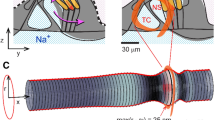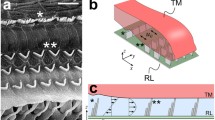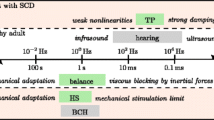Abstract
The cochlea is an important auditory organ in the inner ear. In most mammals, it is coiled as a spiral. Whether this specific shape influences hearing is still an open problem. By employing a three-dimensional fluid model of the cochlea with an idealized geometry, the influence of the spiral geometry of the cochlea is examined. We obtain solutions of the model through a conformal transformation in a long-wave approximation. Our results show that the net pressure acting on the basilar membrane is not uniform along its spanwise direction. Also, it is shown that the location of the maximum of the spanwise pressure difference in the axial direction has a mode dependence. In the simplest pattern, the present result is consistent with the previous theory based on the Wentzel–Kramers–Brillouin-like approximation (Manoussaki et al., Phys Rev Lett 96:088701, 2006). In this mode, the pressure difference in the spanwise direction is a monotonic function of the distance from the apex and the normal velocity across the channel width is zero. Thus, in the lowest-order approximation, we can neglect the existence of the Reissner’s membrane in the upper channel. However, higher responsive modes show different behavior and, thus, the real maximum is expected to be located not exactly at the apex but at a position determined by the spiral geometry of the cochlea and the width of the cochlear duct. In these modes, the spanwise normal velocities are not zero. Thus, it indicates that one should take into account the detailed geometry of the cochlear duct for a more quantitative result. The present result clearly demonstrates that the spiral geometry and the geometry of the cochlear duct play decisive roles in distributing the wave energy.
Similar content being viewed by others
References
Manoussaki, D., Dimitriadis, E.K., Chadwick, R.S.: Cochlea’s graded curvature effect on low frequency waves. Phys. Rev. Lett. 96, 088,701 (2006)
Flecher, H.: Auditory patterns. Rev. Mod. Phys. 12, 47–65 (1940)
Robles, L., Ruggero, M.A.: Mechanics of the mammalian cochlea. Physiol. Rev. 81, 1305 (2001)
Helmholtz, H.L.: On the Sensations of Tone as a Physiological Basis for the Theory of Music. Dover, New York (1954)
Dallos, P., Popper, A.N., Fay, R.R. (eds.): The Cochlea. Springer, New York (1996)
Eatock, R.A., Fay, R.R., Popper, A.N. (eds.): Vertebrate Hair Cells. Springer, New York (2006)
Gummer, A.W. (ed.): Biophysics of the Cochlea. World Scientific, Singapore (2003)
Hudspeth, A.J.: Mechanical amplification of stimuli by hair cells. Curr. Opin. Neurobiol. 7, 480–486 (1997)
von Békésy, G.: Experiments in Hearing. McGraw-Hill, New York (1960)
Loh, C.H.: Multiple scale analysis of the spirally coiled cochlea. J. Acoust. Soc. Am. 74, 95–103 (1983)
Steele, C.R., Zais, J.G.: Effect of coiling in a cochlear model. J. Acoust. Soc. Am. 77, 1849–1852 (1985)
Viergever, M.A.: Basilar membrane motion in a spiral-shaped cochlea. J. Acoust. Soc. Am. 64, 1048–1053 (1978)
Kern, A.: A nonlinear biomorphic hopf-amplifier model of the cochlea. Ph.D. Thesis, Swiss Federal Institute of Technology (ETH), Zürich (2003)
Homer, M., Champneys, A., Hunt, G., Cooper, N.: Mathematical modeling of the radial profile of basilar membrane vibrations in the inner ear. J. Acoust. Soc. Am. 116, 1025–1034 (2004)
Lighthill, J.: Energy flow in the cochlea. J. Fluid Mech. 106, 149–213 (1981)
Riley, K.F., Hobson, M.P., Bence, S.J.: Mathematical Methods for Physics and Engineering, 3rd edn. Cambridge University Press, Cambridge (2006)
Lighthill, J.: Waves in Fluid. Cambridge University Press, Cambridge (2005)
Ruggero, M.A., Narayan, S.S., Temchin, A.N., Recio, A.: Mechanical bases of frequency tuning and neural excitation at the base of the cochlea: comparison of basilar-membrane vibrations and auditory-nerve-fiber response in chinchilla. Proc. Natl. Acad. Sci. U. S. A. 97, 11744–11750 (2000)
Steele, C.R., Taber, L.A.: Comparison of WKB calculations and experimental results for three-dimensional cochlear models. J. Acoust. Soc. Am. 65, 1007–1018 (1979)
Author information
Authors and Affiliations
Corresponding author
Rights and permissions
About this article
Cite this article
Zhang, Y., Kim, C.K., Lee, KJB. et al. Resultant Pressure Distribution Pattern along the Basilar Membrane in the Spiral Shaped Cochlea. J Biol Phys 33, 195–211 (2007). https://doi.org/10.1007/s10867-007-9052-1
Received:
Accepted:
Published:
Issue Date:
DOI: https://doi.org/10.1007/s10867-007-9052-1




